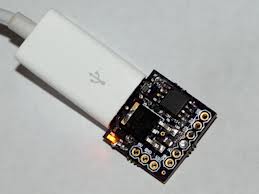For Christmas, my daughter gave me a couple of
Digispark boards. These little, relatively Arduino-compatible, ATtiny85 micro-controller, USB-equipped wonders are programmed from a notebook and will be the basis for a couple of my new projects. I also received word that my
Spark Core has shipped. It’s a Wi-Fi-on-a-chip bolted to the back of a tiny Arduino.

These two offerings were dreamed up and built by a re-born genre of developer who harkens back to the early days of solid-state computing. They design, engineer, fabricate and sell sophisticated, built-from-scratch products to customers who, in turn, use them in their own product development. The commercial do-it-yourself ecosystem has been rapidly maturing in a number of areas, from drones to laser cutters to 3-D printers. Now small-scale, production-run electronic components are entering the game. Mobile developers can get in on the trend by keeping a close eye on how these new products evolve and by being ready to seize opportunities. Look to the early days of
Fairchild Semiconductor and
Apple for inspiration. As processes mature, I think it's only a matter of time before we move from the basic chips-on-boards commercial DIY modules (like the
Digispark USB development board, from Digistump, and Spark Core, from
Spark) to complete DIY consumer electronics gadgets, click-together mix and match systems and beyond. There are a lot of smart people taking up commercial DIY and small-production efforts. Mobile development, user interface and portable solutions experts will have a place in this new world of production. Consider:
- You definitely don't need a huge corporation, with a gigantic R&D budget or even venture capital money, to crank out an interesting product.
Digispark had 5,964 initial backers on Kickstarter and generated $313,218 on a $5,000 funding goal. The Spark Core team got 5,549 backers and pulled in $567,968 on a $10,000 goal. That's nearly $900,000 between them.
- Talented individuals and small groups can accomplish amazing things with a basic experience mix of project management, programming, hardware design, marketing, sales and logistics.
The driving force behind Digispark is Erik Kettenberg and a small, family business in Portland, Ore. He's already offering a range of follow-on products to go with the Digispark. The Spark Core group is headed by Zach Supalla, who has a handful of core designers, engineers and marketers working with him. Although his company’s based in Minneapolis, he’s spent a great deal of time in China with his manufacturing vendor, ensuring that the initial production runs went smoothly. You can bet he’s learned a ton about making and delivering a commercial-quality product.
- Times to market on these products are outrageously short.
The Digispark project was successfully funded on Sept. 10, 2012. My daughter ordered a pair right off the website a couple of weeks before Christmas 2013. The units arrived at our door in time to be wrapped and under the tree. That's a little over one year from funding to almost ubiquitous product availability. Spark Core was successfully funded on July 1, 2013. Shortly after, I pre-ordered a single device from the website. Not surprisingly, there’ve been a couple of delays. I fully expect delivery in a few days, since I just received shipment notification. That's six months, folks. How can developers take advantage of this new way of doing business?
- Keep an eye on crowdfunded projects, be valuable and perhaps join a team.
Both the Digistump and Spark Core teams created their own circuits and board design. They also programmed the firmware needed to make the products actually do something. They both built nice e-commerce sites, negotiated manufacturing relationships with foreign vendors and successfully promoted their products to paying customers. Digistump also customized a version of the Arduino IDE with special libraries that customers can use to program the chips. The Spark Core team built a cloud-based infrastructure to give customers the ability to program and interact with the chips when connect to the Internet, from anywhere on the net. That includes connecting over 3G and 4G, by the way. This means that somebody had to design and build the websites. Somebody had to meet and hash out the details of manufacturing with the vendors. Developers had to build the mobile and Web apps that work with the devices. The Wi-Fi and cloud-based back ends were additional infrastructure that someone had to design and successfully bring into the real world. In other words, there was plenty of work to go around on the teams. Naturally, when you spread out the funding among a handful of team members, not to mention the manufacturing costs, you quickly realize that everyone was either working for peanuts, accomplished an extraordinary amount of work in an extremely short period of time, or perhaps resorted to super-advanced alien technology to get the job done. Scaling up production ought to make them some money now that the designs and logistics have been worked out. And their quest for funding new products, if they ever need to, will be a lot easier since they have a demonstrated track record.
- Cross-pollinate with engineers, business types, sales and, yes, marketers.
No doubt, there had to be outstanding communication and cooperation for both teams to field actual, real-world products. The programmers had to talk to the hardware engineers. Sales and marketing – whether in-house or contractors -- had to be in the loop so the teams generated expectations that matched what the companies could deliver. Everybody had to understand the effects of budget and deadlines, then proceed to get the job done. The old models of programmers just coding and Sales always fighting with Marketing clearly didn’t cut it. Bottom line: If you’re going to be in this kind of environment, the ability to work with others is extremely important.
- Brush up on the rudiments of business skills, international trade and how to make money.
This new model -- particularly with tangible, physical products as opposed to just software -- demands that teams appreciate the skills each member brings to the table. Also, as with any small group, individuals must be ready to step into the breach when another team member is unavailable. Hardware is hard. Pushing a physical product out the door is a monumental task. Being able to handle the business aspects of the effort and pitch on behalf of the company make the new-style, yes-I'm-definitely-versatile developer all the more valuable. Small teams are designing, building and setting up their distribution chains to get hardware products to customers. They’re crowdfunding to get started and running the process from end-to-end. Check out Digispark and Spark Core and see if you aren't impressed.
 These two offerings were dreamed up and built by a re-born genre of developer who harkens back to the early days of solid-state computing. They design, engineer, fabricate and sell sophisticated, built-from-scratch products to customers who, in turn, use them in their own product development. The commercial do-it-yourself ecosystem has been rapidly maturing in a number of areas, from drones to laser cutters to 3-D printers. Now small-scale, production-run electronic components are entering the game. Mobile developers can get in on the trend by keeping a close eye on how these new products evolve and by being ready to seize opportunities. Look to the early days of Fairchild Semiconductor and Apple for inspiration. As processes mature, I think it's only a matter of time before we move from the basic chips-on-boards commercial DIY modules (like the Digispark USB development board, from Digistump, and Spark Core, from Spark) to complete DIY consumer electronics gadgets, click-together mix and match systems and beyond. There are a lot of smart people taking up commercial DIY and small-production efforts. Mobile development, user interface and portable solutions experts will have a place in this new world of production. Consider:
These two offerings were dreamed up and built by a re-born genre of developer who harkens back to the early days of solid-state computing. They design, engineer, fabricate and sell sophisticated, built-from-scratch products to customers who, in turn, use them in their own product development. The commercial do-it-yourself ecosystem has been rapidly maturing in a number of areas, from drones to laser cutters to 3-D printers. Now small-scale, production-run electronic components are entering the game. Mobile developers can get in on the trend by keeping a close eye on how these new products evolve and by being ready to seize opportunities. Look to the early days of Fairchild Semiconductor and Apple for inspiration. As processes mature, I think it's only a matter of time before we move from the basic chips-on-boards commercial DIY modules (like the Digispark USB development board, from Digistump, and Spark Core, from Spark) to complete DIY consumer electronics gadgets, click-together mix and match systems and beyond. There are a lot of smart people taking up commercial DIY and small-production efforts. Mobile development, user interface and portable solutions experts will have a place in this new world of production. Consider:


